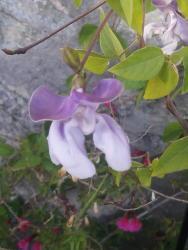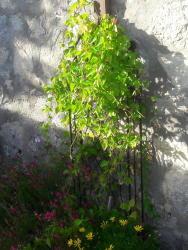Shade Clematis Bed
(Fernery)
This small planting theme relays heavily on foliage and light colors to attract attention into this shady corner. Consisting of a main focal point of two large flowering clematis this pots lower aspects relays heavily on flowers in its front , since it receives the majority of the sunlight, with a switch to foliage as you move towards its interior and into the back.
The back portion is largely predominated by ferns hence the name Fernery. The contrast in foliage forms is subtly but also acts as a foil to the few flowering plants that are located here as well.
Clematis
Clematis
Hyacinth orientalis ' Sky jacket'
-Sky blue flower edged with delicate white provide scent and beauty early in the season. Provide food for early pollinators. Note that as is common with many Hyacinths the flowers spikes may be to heavy and fall over.
Bloom time: Early to midspring
Planting Depth:6 inches ( 4 can do as well)
Hyacinth orientalis 'Carnegie'
-Featuring lemon white flowers which are noted not only for their tallness but also for their sturdiness. As is common with other hyacinth the flowers provide food, interest and scent to the early spring garden.
Bloom time:Early to midspring
Planting depth: 6 inches (4 can do as well)
Dryoptersis erythrosora 'Brilliance'
-A large fern vase like in form that spreads by short rhizomes. This cultivar is noted for its reddish orange foliage. The foliage maintains this color from autumn , with frost gaining in strength, into the spring with green returning but maintaining a reddish cast to them.
Dryoptersis affinis crispa 'The King'
-Known for its crested form this fern appears fluffy and soft to the touch as the usual leaf form has changed so that it ends in small crests. A semi evergreen fern it is recommended that last years growth be cut off once new growth begins to appear to maintain a much cleaner loo.
Dryoptersis cycadina
A Semi evergreen fern from Asia creates structure in the understory. Stems are covered in a hair like structure that gives the stems a black like appearance. Ferns growth habit is shuttlecock in form with the fern sending short rhizomes as it clumps up.
Lobelia siphilitica
-This Missouri native is a rather beautiful lobelia. Featuring flowers on spires that can reach about 3 feet high attracting bees far and wide. May self-sow but recommended seed be collected for nursery purposes. Forms small upright clumps. Prefers to stay moist as most of the plants in this planting do.
Flowering time: July to September
Viola ordata
-Rather a thug in the open garden but a pretty thug . This viola forms small clumps and gently spreads about so that in this planting it serves much the same function as the geranium in creating a sense of unity. Small flowers appear all year but with main flushes being in the darkest of moths. Plant has two flowers the one on top and another below ground that is midge pollinated and forms into a bulbil.
Bloom time: February -April
Viola 'Heartthrob'
- A new viola which features handsome dark variegation leaves which resemble the outline of a heart hence the name. Rarely flowering, the flowers are small and shape and pale pinkish purple. A small clump would look nice appearing beneath a ferns fronds.
Bloom time: February - April
Lysimachus nummularia 'Aurea'
-A yellow foliage variegation of the typical green species. The yellow stays with the more exposure to the sun . Would look perfect on the front edge of the pot to trail off and cover the pot. Small yellow flowers appear in the axials of the plant and attract bees and butterflies. The growth of this plant should be encouraged to hang and creep out any growth heading inwards should be removed and used for propagation purposes, this is because this plant may be a bet of thug if to happy.
Bloom time: June
Sedum sieboldii f. Variegatum
-Form a small semi trailing mound of variegated succlet foliage. Rather rare to find and to propagate. Plant gains the best color with the more sun exposure. Should be planted near the edge of the pot to break the edge and perhaps even trail off a bit.
Bloom time: Late summer till mid fall
Narcissus 'Tete-a-Tete'
-One of the most common daffodil available today this one represents the classical image of what these plants are supposed to represent. Scented blooms early in the spring. Considered division XII , is a miniature.
Bloom time:April
Glechoma hederacea 'Variegata'
-Another creeping plant to soften the edge. This Nepeta relative features variegated trailing vine like growth which is fragrant when bruised. Growth must be monitored with the majority of it being forced over the edge of the planting to soften the edge. Leaf axials root when touching soil. This can be used to propagate more for the nursery. Purple flowers attract honeybees.
Bloom time:Midspring-late spring
Mazus reptans
-Another excellent creeper. This one being the lowest growing of the lot. Having no true preface of sun or shade this species shall be allowed to roam around all sections of the planting as the chances of it dominating are slim to none. Small blue flowers appear during the infamous June gap. Should any portions be near the edge of the pot they should be encouraged to hang off a bit as to soften the edge of this planting.
Bloom time: June to July
Heliopsis helianthoides var. scabra 'Loraine sunshine'
- A sunflower relative with variegated foliage. The foliage may look chronic but it is rather unusual and attractive. In fact in this type of growing conditions this foliage type acts rather like a highlight in this dark space. Sunflower blooms appear late in the season and attract many pollinators. Noted that if to stressed the plant may suffer from fungal and aphid attacks. Seeds have been notated to produce identical offspring to the parent.
Bloom Time: Midsummer to early fall
Acorus variegatus 'Ogon'
-Light green slightly variegated leaves. As typical of many acorus the leaves are scented and in this case like lemons. Moister loving but can tolerant drought. Linear foliage breaks up the pattern created by the ferns. Small aroid flowers emerge late in the season and attract soliatery bees and flies.
Bloom time:Winter
Echinacea purpurea 'White swan'
-Similar to the species but white instead. Noted for a lemony fragence. Rather tall but statured and strong on structure. This prairie perennial is planted towards the front rather then the middle to break up the overall layout of this planting. Pollinator love and post flowering birds eat the seed. Final flowers of the season should be allowed to seed for the purpose stated above.
Bloom time: Midsummer till midfall
Fritillaria meleagris
-A endangered European bulb. Unusual amongst bulbs in that it loves moist spots. Grassy foliage is rather delicate appearance and would merge with that of the other plants later in season before its return to dominancy. Checkered flowers add early interest in the spring way before the plants are in full glory.
Bloom time: April
Planting Depth: I inch, this was done due the small size of the bulb. Regardless the bulb will migrate downwards to a more favorable depth.
Pennisetum 'Burgundy bunny'
-A Dwarf deciduous grass that sure adds impact to the garden. Blades are highlighted with red on the edges and as the season continues this red coloration spreads and increases. Would look with Tete-A-Tete emerging with it in early spring. A note on maintance since this grass is deciduous in nature then its growth should be cut back flush to the ground at least by January or early February. This is done to avoid congestion and create a cleaner healthier look.
Bloom time: Midsummer
Salvia nermosa 'Sensation rose'
-
- A deviation from the typical species this cultivar is reputed to grow more upright but nether the less the bees still love its blooms. Short spikes emerge and act as pinpoints of color amongst the various shade of green that predominate this pot. For repeat flowering deadhead and discard the spent flowers.
Bloom time: June to September
Geranium x cantabrigiense 'Karmina'
-A sterile hybrid this geranium slowly spreads and rambles about a planting, creating a sense of unity. A trait that many in this cross share is scented foliage as well. Recommended to plant so that portions trail off and when individuals walk by they my brush against it releasing the foliage scent as one passes along.
Bloom time: May to June
Nicotiana alata
-Often considered a annual when it fact it is a tender perennial that given a sheltered position such as the on in this bed it will multiply and flower for years to come. Rather splindly in growth this plant awkward growth shall be hidden by its neighbors but its scent shall not. The straight species is renowned for its strong scent and its for this reason that it is to find residence here.
Bloom time: June till frost
Introducing a tropical vine with a taxonomic mess surrounding it, enter Phaseolus carcalla. A twinning vine native to south America , this vine displays flowers classic to that found in the family legumancea (peas and beans), however of key note is that the flowers are slightly twisted revealing the key attraction of this vine. the flowers unique shape is to aid in the pollination by means of ants. Ants are the key pollinators of both these genus's, The reason for the taxonomic mess is due to that of its near relative Vigna carcalla.
The key difference between the two is in the flower. Foliage are nearly identical but it is in the flower color that one can easily tell the species apart. Our plant of the month is purple and scentless vs Vigna carcalla which is white with pink and with a strong scent said to resemble violets. growth habits and much the same with both vines behaving as semi evergreens if frosts are not to hard although that has yet to be observed in my own garden (watch this space).
Perhaps the reason as to why there is so much confusion is due to how so many of us gardeners come across this plant. When we had fist stumbled upon this jewel it was at a Home depot in spring it was being sold as Vigna carcalla yet when it first bloomed did it reveal its true identity. Neither the less it has proven itself worth its space. It inhabits a dry narrow bed on the side of a pool where the soil is shape draining and baked by the sun. This vine has thrived yet its hardiness has yet to be seen as this winter has been mild to the extreme.


Many think of that far off city of El Paso Texas, as simply a desert. A desert landscape which is predominated by the stereotypical cactus and tumble weed but that is further then the truth and the reality of growing conditions is quiet extronadarly. The fact is that in a standard housing one can find the tropical equator, temperate woodlands, spiny xeriscapes, and pollinator filled cottage beds. What I just described is my humble back garden... a growing botanical garden.